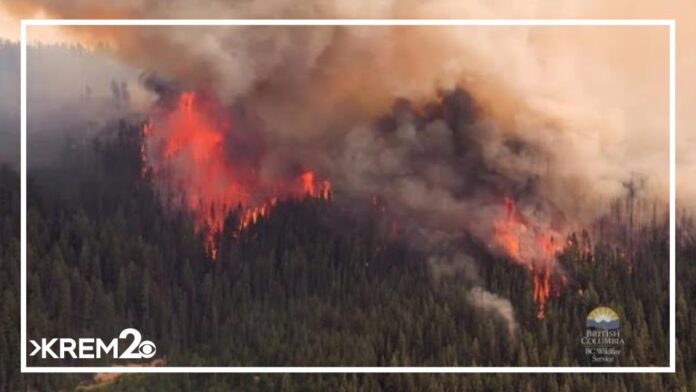A catastrophic wildfire scorches the town of Jasper, prompting a mass evacuation as the blaze ravages up to half of its structures
A catastrophic wildfire has roared into Jasper, Alberta, threatening the heart of the Canadian Rockies’ largest national park. The inferno, which began spreading rapidly earlier this week, has prompted the evacuation of approximately 25,000 people, including both residents and visitors. The fire has reached the town with flames towering higher than treetops, causing widespread destruction to up to half of Jasper’s structures.
On Thursday, Jasper Mayor Richard Ireland expressed profound sorrow in a letter posted on the town’s website, acknowledging the “beyond description and comprehension” loss experienced by the community. Premier Danielle Smith of Alberta reported that between 30% and 50% of the town’s buildings might be damaged or destroyed. Tearfully reflecting on Jasper’s natural beauty and its importance to local families, Smith pledged significant support for the rebuilding process.
The town of Jasper and the adjoining Jasper National Park had been under severe threat from fires approaching from both directions. The rapid spread of the fire was exacerbated by high winds, with gusts moving the blaze up to 5 kilometers (3 miles) in under 30 minutes. Alberta Public Safety Minister Mike Ellis described the situation as “a wall of fire” with flames reaching up to 100 meters high, making firefighting efforts almost futile.
Pierre Martel from Parks Canada described the wildfire as a “monster,” stating that the combination of lightning, strong winds, and drought conditions led to the fire’s rapid expansion. Despite efforts to control the blaze, the fire remains out of control, with only a small amount of rain providing minimal relief. Parks Canada has confirmed that no injuries have been reported, and all individuals—residents, visitors, and responders—are safe.
Annelies Lagger, a local business owner who has lived in Jasper for 30 years, recounted her harrowing escape with her pets. She expressed uncertainty about her property’s fate and her future, describing the destruction as devastating. Lagger is now seeking shelter in Valemount, British Columbia, while trying to cope with the loss of her home and community.
Prime Minister Justin Trudeau has approved federal assistance for Alberta, including military support, to aid in the firefighting efforts. The wildfire crisis is part of a larger pattern of extreme fire activity across the province, with 176 wildfires burning, including 54 that are out of control. The province has been gripped by intense heat, forcing additional evacuations from remote communities. International firefighters from Australia, Mexico, New Zealand, and South Africa are arriving to assist in combating the blazes.
Jasper National Park, designated a UNESCO World Heritage Site in 1984, is renowned for its stunning mountain landscapes. The current wildfire crisis underscores the growing challenges posed by climate change and extreme weather events.
Analysis:
Political:
The wildfire crisis in Jasper highlights the urgent need for effective disaster management and climate adaptation policies. The response from federal and provincial governments, including the deployment of military resources and international aid, reflects the severity of the situation and the high stakes involved. This event could influence future policy decisions on climate resilience and emergency response strategies.
Social:
The impact of the wildfire on Jasper’s community underscores the profound emotional and social toll of natural disasters. The mass evacuation and destruction of homes and businesses have disrupted the lives of thousands, revealing the human cost of such crises. The story of individuals like Annelies Lagger illustrates the personal hardships faced by residents, emphasizing the need for community support and mental health resources during recovery.
Racial:
While the wildfire’s immediate effects are not racially specific, the broader implications of climate change and environmental degradation can disproportionately affect marginalized communities. In Canada, Indigenous populations and lower-income communities often face greater vulnerability to the impacts of natural disasters, including displacement and loss of traditional lands.
Gender:
The gendered aspects of disaster response and recovery are evident in how different groups experience and cope with the crisis. Women, particularly those managing households or businesses, may face unique challenges in accessing resources and support. The response to the wildfire must consider gender-sensitive approaches to ensure equitable support for all affected individuals.
Economic:
The economic repercussions of the wildfire are significant, with substantial damage to infrastructure and property in Jasper. The costs of rebuilding and restoring the town will be considerable, impacting local businesses and the tourism industry. The disaster also highlights the economic strain on emergency services and the potential long-term effects on Alberta’s economy due to ongoing wildfires and climate-related challenges.
